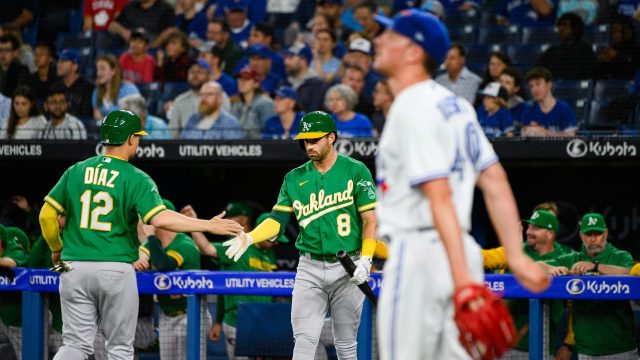
You can understand why Rob Manfred is taking a bit of a victory lap these days.
For a guy who supposedly hates baseball, the commissioner has done a remarkable job of overseeing the improvement of the on-field product; of creating an environment where the right people in the right places can make mostly right decisions. And there he was recently, being interviewed by TIME magazine in its “Time 100: Most Influential Companies” edition. Next stop will be Major League Baseball’s All-Star Game in Seattle in mid-July.
Putting out the usual caveat — that it’s been decades since Major League Baseball had a commissioner who was anything other than a CEO whose major responsibility is increasing franchise value and revenue; that the commissioner’s job is to view us not as fans but consumers – it’s tough to argue against Manfred being on track to be the most influential if not successful commissioner in our lifetime.
And — oddly, again, given that so many of the chattering classes are convinced that he doesn’t like the game — the most obvious manifestation of his early legacy is an improvement on the field.
While it makes sense to collect a full season’s worth of data before fully understanding the impact of the game’s new rules — not just attendance; the rate of pitching injuries has emerged as a player concern and the elephant in the room will continue to be the spectre of a post-season game and possibly even series being decided on a pitch-clock violation — the pitch timer has created new boundaries in an old game within which further improvement can take place. Anecdotally, it seems to me that the game is a little less of what it was last season and a little more of how I remember it 20 or so years ago — but hardly revolutionary.
They’ve placed a clock on a game that celebrates timelessness, and that’s something a lot of us couldn’t foresee, let alone embrace. The next step won’t be “robo-umps” — can we please toss that word into the trash bin? — but there will at least be some kind of challenge system for balls and strikes. Eventually, umpires will be calling balls and strikes based on a fully electronic strike zone. As both Manfred and Morgan Sword, MLB’s executive vice-president of operations, have said, a major issue is that the strike zone is more oval-shaped than the box shown on telecasts. The question is: does the zone adapt to technology or will baseball want technology to adapt to the zone?
It’s not as easy as all that: The manager of the Toronto Blue Jays’ triple-A affiliate, Casey Candaele of the Buffalo Bisons, told us on Blair & Barker that the triple-A games using a fully electronic zone have taken longer because the top of the zone is so iron-clad, pitchers are forced to throw the ball over the plate more. More balls in play equals more action … and more time and arms used to put nine innings in the book. Candaele is not a fan of the fully automated system. A good rule of thumb is to beware the unintended consequences of rule changes.
There have, in my lifetime, been seismic off-field events when it comes to baseball. Free agency, the ascendency of the Major League Baseball Players Association, the drug scandals of the 1970s, expansion and franchise movement, the 1994 strike and subsequent overhaul of the divisional and post-season formats, the abolition of league offices and unification of umpires, the cloud of steroid and PED usage and the wholesale embracing of sports wagering. Damn. But until PitchCom, the major on-field change — barring physical size of players and more specialized roles — has been, what? The designated hitter? It took 49 years for the National League to adopt the DH after the American League started using it in 1973.
Bigger bases. Different rules regarding disengagement with men on base. The placing of an automatic baserunner on second base in extra innings — I call it the “Manfred Man” — this has all happened on Manfred’s watch. Hell, that would have been a good decade’s worth of change a few years ago.
Determining Manfred’s off-field success depends to a degree on how amoral you want to be. I mean, it’s sad that the Oakland Athletics seem to be bound for Las Vegas but, c’mon: Oakland’s ballpark is a dump and there clearly wasn’t enough political support to come up with a funding model that worked for ownership. Political leaders in both jurisdictions came to different conclusions and that, unfortunately, is the bottom line. It’s messy and nasty and all the bad things you can come up with because that’s how it always is when a team pulls up stakes and moves. And, yes, your heart aches for Athletics fans — just as it did for Montreal Expos fans.
For Manfred, moving the Athletics to Las Vegas will increase franchise value while, of course, nudging cities with teams facing ballpark issues of their own. Creating a climate where expansion now seems an inevitability brings a new level of seriousness to markets wanting a franchise. It’s a clear signal that growth is very much in play.
True, much of this operates independently of the commissioner. Economic, systemic and societal influences are not always in his control. But the very best sports administrators do one thing well: they get out of their own way, and limit own goals. To that end, Manfred has made mostly minor missteps that have seen him crushed on social media: his comments cheapening the World Series trophy, his snide comment about attendance at a game in Oakland during a fans’ protest … and passing the buck on the concept of recognizing Pride promotions, essentially saying it’s up to teams to read their room locally while urging them to avoid putting Pride logos or badges on game uniforms.
It is perhaps his biggest point of departure from his predecessor, Bud Selig, who generally bent over backward to avoid blaming fans or players (publicly, at least) for issues related to the game. Selig had several flaws as a commissioner. But as a long-time owner and fan, there was never any doubt about his emotional ties to the game and its players. I’ve often thought it was a point of weakness when it came to dealing with PEDs in particular.
Manfred, meanwhile, used the TIME article to suggest that if he had a do-over, he wouldn’t necessarily have granted immunity to players involved in the Houston Astros scandal. Maybe that was just him musing … but it would fly in the face of do-nothing to impugn the integrity of the most important part of your product: the players.
Manfred still has some heavy lifting to do. It appears as if there is a renewed appetite among owners for a hard salary cap, and in some way Manfred is to blame for that — because the consensus is he’s had two successful negotiations with the MLBPA that have tilted labour momentum back toward owners.
That’s always been a third rail for players. Despite his mishandling of the Pride issue, diversity and inclusivity are going to be a point of emphasis not for any great sense of morality from the point of view of ownership, but as potentially important marketing factors. And cleaning up the cesspool that is scouting and recruiting in Latin America is also an economic matter as much as it is something that needs to be done for the greater good.
The next big move? The more balanced schedule and the acceptance of the universal DH is a clear step toward a wholesale realignment that will radically re-arrange divisions and leagues, account for expansion and make the changes that came out of the 1994 players’ strike seem miniscule.
So, the guess here is this isn’t the last victory lap Manfred takes. I wouldn’t say Selig nearly killed the game with love, but he did impede its progress. Manfred may not like the game, but it seems as if he’s helped breathe new life into it.








